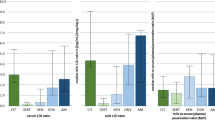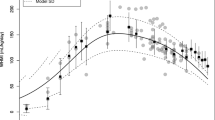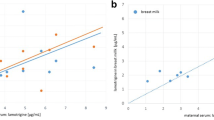Abstract
This study characterises the extent of desvenlafaxine transfer into milk and provides data on infant exposure to desvenlafaxine via breast milk in ten women with postnatal depression and their breastfed infants. Desvenlafaxine concentration in milk and plasma was measured chromatographically in milk and in maternal and infant plasma collected at steady state. Theoretic and relative infant doses via milk were estimated and the per cent drug in infant versus mother’s plasma was calculated. Theoretic infant dose via milk was 85 (53–117) μg kg−1 day−1 (mean and 95% confidence interval) and relative infant dose was 6.8% (5.5–8.1%). The ratio of drug in infant/maternal plasma also gave an infant exposure estimate of 4.8% (3.5–6.2%) for all ten infants and 5.3% (4.2–5.7%) in the eight infants who were exclusively breastfed. No adverse effects were seen in the infants. The relative infant dose was similar to that for previous studies using venlafaxine and was supported by a separate exposure measure using the ratio of drug in the infant’s plasma relative to that in the mother’s plasma. The theoretic infant dose of desvenlafaxine was 41–45% of that for venlafaxine and its metabolite desvenlafaxine in previous studies, reflecting the lower recommended maternal dose for desvenlafaxine. Although our data for desvenlafaxine use in lactation are encouraging and there are supporting data from venlafaxine studies, more patients and their infants need to be studied before the safety of desvenlafaxine as a single therapeutic agent can be fully assessed.

Similar content being viewed by others
References
Bennett PN (1996) Use of the monographs on drugs. In: Bennett PN (ed) Drugs and human lactation, 2nd edn. Elsevier, Amsterdam, pp 67–74
Briggs GG, Ambrose PJ, Ilett KF, Hackett LP et al (2009) Use of duloxetine in pregnancy and lactation. Ann Pharmacother 43:1898–1902
Clayton AH, Kornstein SG, Rosas G, Guico-Pabia C et al (2009) An integrated analysis of the safety and tolerability of desvenlafaxine compared with placebo in the treatment of major depressive disorder. CNS Spectr 14:183–195
Frankenburg WK, Dodds J, Archer P, Shapiro H et al (1992) The Denver II: a major revision and restandardization of the Denver developmental screening test. Pediatrics 89:91–97
Hendrick V, Altshuler L, Wertheimer A, Dunn WA (2001) Venlafaxine and breast-feeding. Am J Psychiatry 158:2089–2090
Ilett KF, Hackett LP, Dusci LJ, Roberts MJ et al (1998) Distribution and excretion of venlafaxine and O-desmethylvenlafaxine in human milk. Br J Clin Pharmacol 45:459–462
Ilett KF, Kristensen JH, Hackett LP, Paech M et al (2002) Distribution of venlafaxine and its O-desmethyl metabolite in human milk and their effects in breastfed infants. Br J Clin Pharmacol 53:17–22
Lobo ED, Loghin C, Knadler MP, Quinlan T et al (2008) Pharmacokinetics of duloxetine in breast milk and plasma of healthy postpartum women. Clin Pharmacokinet 47:103–109
Lucas A, Gibbs JA, Lyster RL, Baum JD (1978) Creamatocrit: simple clinical technique for estimating fat concentration and energy value of human milk. Br Med J (Clin Res Edn) 1:1018–1020
Newport DJ, Ritchie JC, Knight BT, Glover BA et al (2009) Venlafaxine in human breast milk and nursing infant plasma: determination of exposure. J Clin Psychiatry 70:1304–1310
Papakostas GI, Thase ME, Fava M, Nelson JC et al (2007) Are antidepressant drugs that combine serotonergic and noradrenergic mechanisms of action more effective than the selective serotonin reuptake inhibitors in treating major depressive disorder? A meta-analysis of studies of newer agents. Biol Psychiatry 62:1217–1227
Perry R, Cassagnol M (2009) Desvenlafaxine: a new serotonin–norepinephrine reuptake inhibitor for the treatment of adults with major depressive disorder. Clin Ther 31:1374–1404
Thase ME (2008) Are SNRIs more effective than SSRIs? A review of the current state of the controversy. Psychopharmacol Bull 41:58–85
Thomann P (1993) Non-compartmental analysis methods manual. In: Heinzel G, Woloszcak R, Thomann P (eds) TopFit 2.0 pharmacokinetic and pharmacodynamic data analysis system for the PC. Gustav Fischer, Stuttgart, pp 5–66
Wyeth Australia Pty Ltd. (2010) Pristiq Product Information. Wyeth Australia Pty Ltd., Baulkham Hills, Australia, pp 1–15. Available at: http://www.pbs.gov.au/html/healthpro/search/results?term=Pristiq&publication=GE. Accessed 12 Mar 2010
Acknowledgements
The authors gratefully acknowledge the assistance of the nursing staff of the Mother Baby Unit at the King Edward Memorial Hospital. Funding of the laboratory measurements for the study was provided by Wyeth Australia Pty Limited, 17–19 Solent Circuit, Norwest Business Park, Baulkham Hills, 2153, Australia.
Author information
Authors and Affiliations
Corresponding author
Rights and permissions
About this article
Cite this article
Rampono, J., Teoh, S., Hackett, L.P. et al. Estimation of desvenlafaxine transfer into milk and infant exposure during its use in lactating women with postnatal depression. Arch Womens Ment Health 14, 49–53 (2011). https://doi.org/10.1007/s00737-010-0188-9
Received:
Accepted:
Published:
Issue Date:
DOI: https://doi.org/10.1007/s00737-010-0188-9




